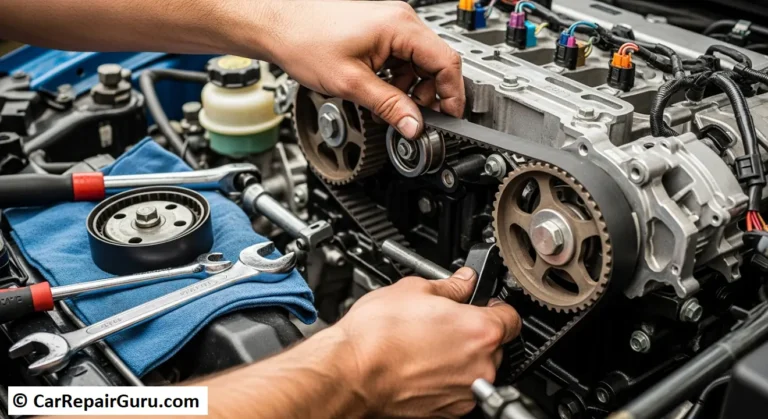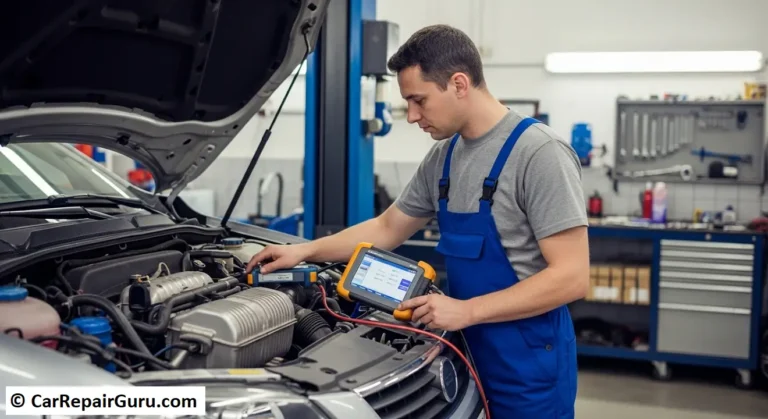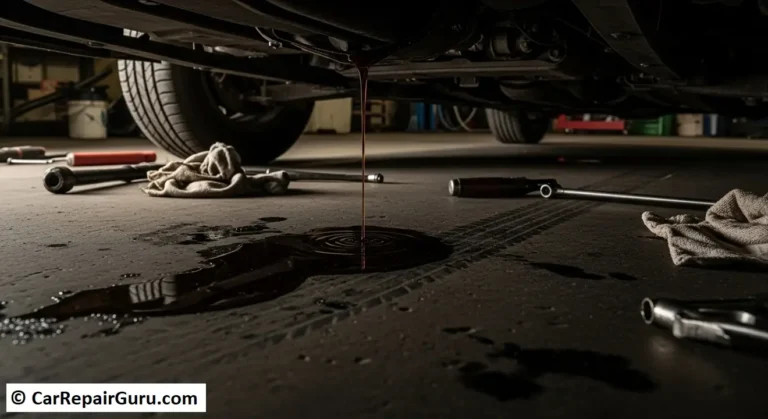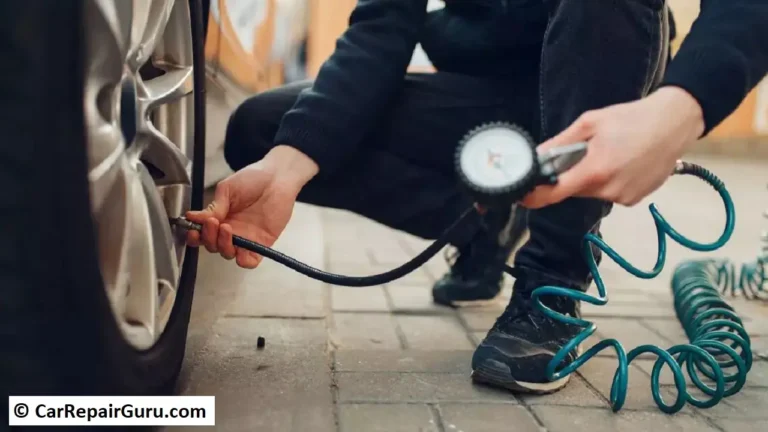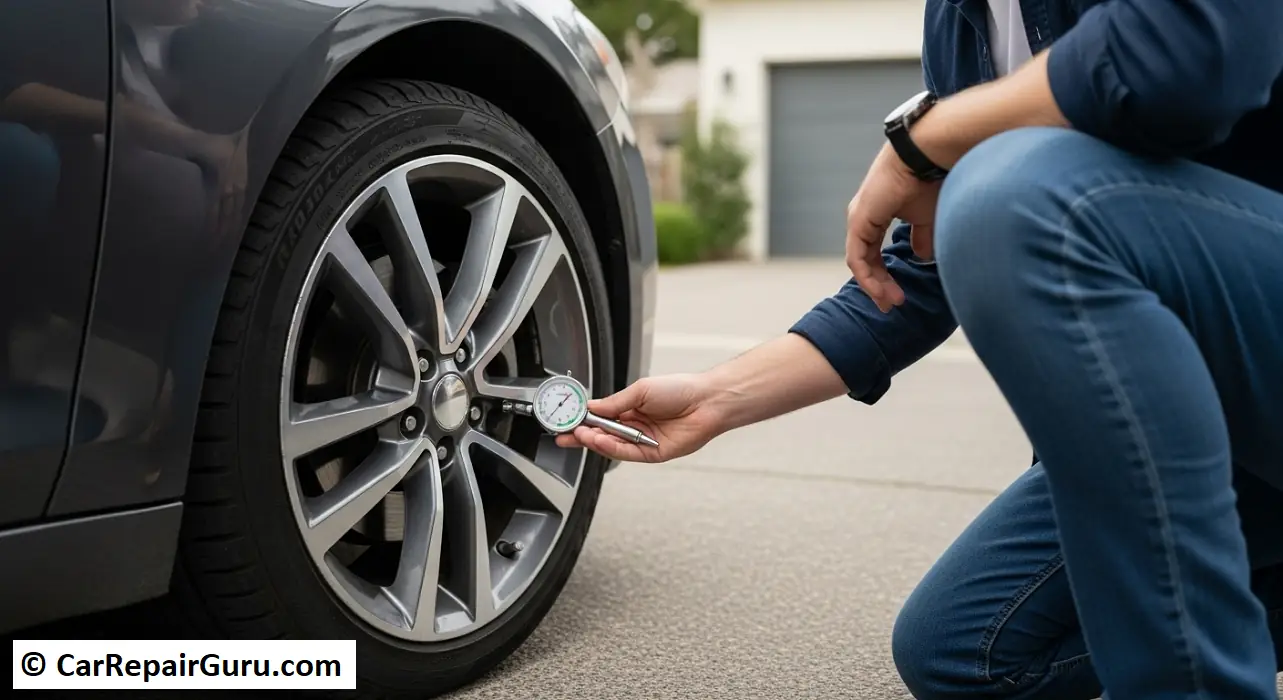
Did you know that nearly 1 in 4 cars on the road has at least one tire that’s significantly underinflated? This simple oversight costs drivers billions in wasted fuel and causes thousands of preventable accidents each year. Learning how to check your car’s tire pressure isn’t just about following maintenance schedules—it’s about protecting your wallet, your safety, and the environment.
Proper tire pressure affects everything from your car’s handling and braking distance to fuel economy and tire lifespan. Whether you’re a new driver or someone who’s been putting off this essential task, this guide will walk you through exactly how to check tire pressure like a pro. You’ll discover the right tools, perfect timing, and step-by-step techniques that take less than 10 minutes but can save you hundreds of dollars annually.
Why Checking Tire Pressure Matters
Your tires are the only part of your vehicle that touches the road, making proper tire pressure one of the most critical safety factors you can control. When your tires maintain the correct PSI (pounds per square inch), you’re not just following manufacturer recommendations—you’re actively protecting yourself and others on the road.
Safety comes first. Underinflated tires generate excessive heat, increasing your risk of dangerous blowouts, especially during highway driving or hot weather. They also reduce your vehicle’s stability during emergency maneuvers and increase stopping distances by up to 10%. Overinflated tires aren’t safe either. They provide less contact with the road surface, which reduces traction and makes your car more prone to skidding, especially in wet conditions.
Your wallet will thank you. The U.S. Department of Energy reports that properly inflated tires can improve fuel efficiency by up to 3.3%. For the average driver, this translates to saving about $0.12 per gallon. More importantly, correct tire pressure can extend tire life by 25% or more, potentially saving you hundreds of dollars on premature replacements.
Environmental benefits matter too. When your tires are properly inflated, your engine works more efficiently, reducing carbon emissions. Additionally, longer-lasting tires mean fewer tires in landfills—a win for everyone.
The performance benefits are immediately noticeable. Properly inflated tires provide better handling, a smoother ride, and improved traction. Your car will feel more responsive and stable, especially during cornering and lane changes.
When to Check Your Tire Pressure
Timing is everything when it comes to accurate tire pressure readings. The golden rule is to check your tires when they’re “cold”—meaning the vehicle hasn’t been driven for at least three hours, or ideally, first thing in the morning.
As you drive, friction generates heat, causing the air inside your tires to expand. This can increase tire pressure by 4-6 PSI, giving you a false, inflated reading. Checking hot tires might lead you to think your pressure is fine when it’s actually too low.
- Monthly Checks: Tires naturally lose about 1-2 PSI per month. A monthly check is essential to catch this gradual loss.
- Seasonal Changes: For every 10°F drop in temperature, your tires lose about 1 PSI. Check more frequently during seasonal transitions.
- Before Long Trips: Highway driving and heavy loads put extra stress on tires. Always check them before a road trip.
- TPMS Light: If your Tire Pressure Monitoring System (TPMS) light comes on, check your pressure immediately. Don’t wait for the light, as it often only activates when pressure is already dangerously low (about 25% under).
What You’ll Need to Check Tire Pressure

Having the right tools makes the job quick and accurate. You’ll need a reliable pressure gauge and access to an air source.
Tire Pressure Gauge Comparison
| Gauge Type | Accuracy | Ease of Use | Average Cost | Notes |
|---|---|---|---|---|
| Digital | Excellent | Very Easy | $15 – $30 | Most accurate and easy to read, but requires batteries. |
| Dial | Very Good | Easy | $10 – $25 | Durable and reliable with an easy-to-read analog dial. No batteries needed. |
| Stick | Good | Fair | $2 – $5 | Very affordable and compact, but can be harder to read precisely. |
You will also need:
- An Air Source: Most gas stations have air compressors. Alternatively, a portable compressor ($30-$100) is a great investment for at-home convenience.
- Your Vehicle’s Manual/Door Jamb Sticker: This is where you find the correct PSI for your car.
Step-by-Step Guide: How to Check Tire Pressure
Step 1: Find Your Recommended PSI
The correct pressure for your car is set by the vehicle manufacturer, not the tire company. **Do not use the “Max Press” number on the tire’s sidewall.**
- Check the Door Jamb: Open the driver’s side door and look for a sticker on the door frame. It lists the recommended cold PSI for the front and rear tires.
- Check the Owner’s Manual: If the sticker is missing or unreadable, find the information in your owner’s manual under a “Tires” or “Specifications” section.
Note that front and rear tires may require different pressures.
Example Recommended PSI (Check Your Vehicle for Specifics)
| Vehicle Type | Typical Front PSI | Typical Rear PSI |
|---|---|---|
| Compact Sedan | 32 PSI | 32 PSI |
| Mid-Size SUV | 35 PSI | 35 PSI |
| Full-Size Truck | 35 PSI | 40 PSI |
Disclaimer: These are examples only. Always use the values on your vehicle’s door jamb sticker.
Step 2: Remove the Valve Cap
Locate the small, half-inch rubber or metal valve stem on each wheel. Unscrew the plastic cap (turn it counterclockwise) and put it somewhere safe, like your pocket, so you don’t lose it.
Step 3: Use Your Tire Pressure Gauge
Press the gauge onto the valve stem firmly and quickly. You’ll hear a brief hiss of air. Hold the gauge straight to ensure a good seal and an accurate reading. If the hissing continues, you don’t have a good seal—remove the gauge and try again.
Step 4: Read and Record the Pressure
Compare the reading from your gauge to the recommended PSI from your door jamb sticker. Write down the pressure for each tire. This helps you track any tires that are losing air faster than the others, which could signal a slow leak.
Step 5: Repeat for All Tires (and the Spare!)
Check the pressure on all four tires. Don’t forget your spare tire, which is often overlooked but crucial in an emergency. Spare tires usually require much higher pressure (often 60 PSI), so check its specific requirement. Once finished, screw all the valve caps back on tightly.
How to Add Air to Your Tires
If a tire is low, you’ll need to add air.
- Go to a gas station or use your portable compressor.
- Set the target PSI on the machine if it has an automatic inflator.
- Press the air hose nozzle firmly onto the valve stem.
- Add air in short bursts (15-20 seconds at a time).
- After each burst, re-check the pressure with your own gauge. This prevents overinflation.
- If you add too much air, gently press the small pin in the center of the valve stem with a key or the back of your gauge to release air until it’s at the correct level.
Understanding Tire Pressure Monitoring Systems (TPMS)
Modern vehicles come equipped with a TPMS that alerts you when tire pressure drops. However, it’s a safety net, not a substitute for manual checks.
- How it Works: Sensors in each wheel monitor pressure and send data to your car’s computer. The system triggers a warning light (a horseshoe shape with an exclamation point) when pressure drops about 25% below the recommended level.
- System Limitations: The warning only activates when pressure is dangerously low, not just slightly low. By the time the light comes on, your fuel economy and tire wear have already been negatively affected.
- Why Manual Checks Remain Necessary: Relying only on your TPMS is like only going to the doctor when you’re already very sick. Regular monthly checks with a gauge allow you to maintain optimal pressure for safety, tire life, and fuel efficiency.
Common Tire Pressure Mistakes to Avoid
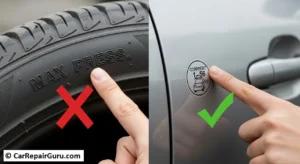
Avoiding these common errors will ensure your tires are always properly maintained.
Checking “Hot” Tires: Driving heats up your tires, increasing the pressure by 4-6 PSI and giving you a false reading. Always check tires when they are cold.
Using the “Max Pressure” on the Sidewall: This number is the maximum pressure the tire can safely hold, not the recommended pressure for your vehicle. Always use the PSI on your car’s door jamb sticker.
Forgetting the Spare Tire: A flat spare tire is useless in an emergency. Check it monthly and ensure it’s inflated to its specific, often higher, pressure.
Only “Eyeballing” the Tires: Modern radial tires can be 50% underinflated and still look fine. You cannot judge tire pressure by looking at it. Always use a gauge.
Ignoring Seasonal Changes: Forgetting to add air as the weather gets colder is a common oversight that leaves you driving on underinflated tires all winter.
Troubleshooting Common Issues
| Symptom | Possible Cause(s) | What to Do |
|---|---|---|
| One tire is consistently low | Slow leak from a puncture (nail, screw), faulty valve stem, or corroded wheel rim. | Visually inspect the tire for objects. Apply soapy water to the valve stem and tire surface to look for bubbles. Visit a tire shop for professional inspection and repair. |
| TPMS light stays on after inflating | The system may need to be reset. In rare cases, a sensor could be faulty. | Drive for a few miles, as some systems reset automatically. If it stays on, consult your owner’s manual for the manual reset procedure. |
| All tires are low | Normal air loss over time, accelerated by a significant drop in temperature. | This is normal. Inflate all tires to their recommended cold pressure. Check more frequently in cold weather. |
| Gauge gives inconsistent readings | The gauge may be faulty, or you may not be getting a good seal on the valve stem. | Try pressing the gauge on more firmly and squarely. If it still varies, it’s time to invest in a new, quality gauge. |
Take Control of Your Tires
Checking your car’s tire pressure is one of the simplest yet most impactful maintenance tasks you can perform. In just 10 minutes each month, you can improve your safety, save money on fuel and tire replacements, and reduce your environmental impact. The steps are straightforward: find your recommended PSI, use a quality gauge on cold tires, and adjust pressure as needed.
Remember, proper tire pressure isn’t just about following rules—it’s about protecting yourself and others on the road while maximizing your vehicle’s performance and efficiency. Make this simple check a regular part of your routine.
FAQs About Tire Pressure
How often should I check my car’s tire pressure?
At least once a month and before any long road trip.
What happens if I drive with low tire pressure?
It reduces fuel economy, causes premature tire wear, and significantly increases the risk of a dangerous blowout. Handling and braking are also negatively affected.
Why does my tire pressure drop in cold weather?
Air contracts when it gets cold. For every 10°F the temperature drops, your tire pressure will decrease by about 1 PSI.
Should I inflate my tires to the maximum PSI on the tire’s sidewall?
No, never. That number is the maximum pressure the tire can safely hold, not the recommended operating pressure for your vehicle. Always use the PSI listed on your driver’s side door jamb.
